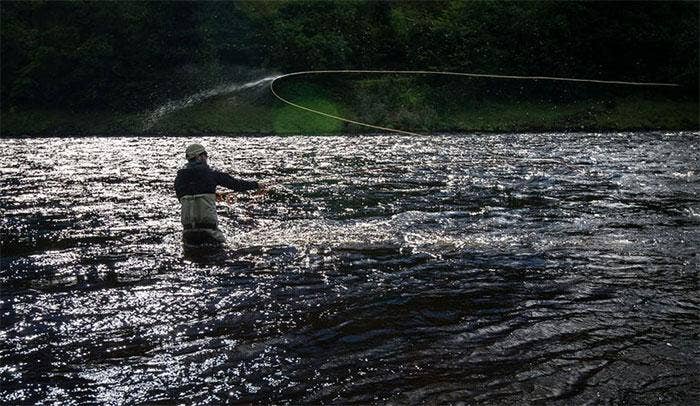Thankfully, unlike a golfer who may need a different club for every part of the course, one salmon rod can cover more than one situation – but not all of them - and having the wrong tool for a given job can be a painful experience.
Jim’s Top Considerations for Double-Handed Fly Fishing Rods
As far as your budget is concerned, salmon rods range from £100 to £1000 but spending a lot of money is not always a guarantee that you will be at one with your new rod. High end rods may offer state of the art technology with lightweight and responsive carbon, top quality cosmetics and, in some cases, a lifetime guarantee with excellent after sales should the worst happen. However, these factors may not be that important if you are simply ‘testing the water’ regarding salmon fishing. Ultimately, you should spend as much as you can afford.“Asking what salmon rod you should buy is like asking how long your leader should be, there is no single answer for every situation” - Jim FearnPrice aside, the main questions to ask yourself are where and when will you be fishing, as the size of river and time of year will dictate the size of flies and type of lines you will be using.

Fly Rods for Spring Salmon Fishing
Let’s start at the beginning of the season, on a big, early spring river. In these conditions you require a rod that:- Can handle heavy lines/shooting heads/fast tips and turn over large tube flies
- Is capable of long casts in harsh conditions and difficult winds
- Can play fish hard in heavy water without folding
- Can mend line and steer heads (often sinking) at range, to give effective water command
The ideal tool would be a 15’ #10 or #11 and my preference would be for a fast action rod capable of delivering high line speed. Such rods have a steely feel and, providing the caster has the necessary technique and room, can wind up a lot of tension during the cast to fire line a long way, even in gale conditions.
Switch Rods for Summer Salmon Fishing
A smaller rod, such as a switch fly rod (a rod between 10ft and 12ft that can also be cast singlehanded), would be a severe disadvantage in these conditions but they offer advantages on smaller summer rivers in low water when you will be fishing lighter line weights.- Are less cumbersome and, in conjunction with shorter heads, make drawing flies in slacker pools more effective
- Allow delicate presentation with light line
- Require less room behind the fisher to make the cast, opening up overgrown or steep-sided river sections
- Are lighter in action and easier to load without much line behind the caster, making it easier to achieve a squarer cast in areas of limited space
Double-Handed Fly Rods - the Middle Ground
The middle ground between the fifteen-footer and the switch would be either a 13’ #8/9 or 14’ #9/10. Jim with a cracking spring salmon!
Jim with a cracking spring salmon!Although only a foot shorter 14-footers feel surprisingly light in the hands compared to 15-footers. This length of rod has been gaining popularity in recent years, mostly down to advances in fly line systems that are now available. Lines such as shorter shooting heads and Skagits enable large flies and fast tips to be cast much more easily than in the old days of full sinking lines (the preserve of 15-footers).
A 14-foot rod is great for floating line work on big/medium rivers in conjunction with Spey lines and it’s not hard to see why they are considered the new all-rounder. However, as with anything termed ‘all-round’ there is a trade off in certain situations and being a foot shorter they are compromised in lifting heavy lines and turn over compared to 15-foot rods and the advantages of a switch rod are lost on small rivers.
13-foot #8 or 9 rods are the preserve of smaller/mid-size rivers or, for my own part, floating/sink tip work with smaller flies on low water big rivers. But what, you may ask, are the failings of a switch rod in these circumstances? The answer is simply range, add a head wind into the equation and I have been beaten in reaching the required distance. It is worth noting that being a couple of feet shorter a switch rod is not always the best choice for short to medium-length Spey lines (often between 50ft and 65ft in length) which I find a great choice for this type of fishing. Short rod/long line is a combination that a lot of people struggle with in my experience.
For the past couple of seasons I have drifted between a fifteen-footer and a switch rod and I haven’t been too compromised. However, I remind myself that no two seasons are ever the same and this year could be different! If I had to be nailed down to just one rod for the fishing I do I would opt for a fourteen-footer despite the fact I would be slightly over gunned in some situations and under gunned in others.
Finally, I feel it is worth pointing out that some rods are sold as line specific, such as shooting head or Skagit or a Spey line rod. I accept I need to have different lines at my disposal but I really do not want to take four rods with me every time I go out. Thankfully, many rods can handle many different types of line system and this is a question worth asking when purchasing – the Sportfish team has a comprehensive understanding of all models and casting styles and will be happy to advise you.
Tight lines,
Jim Fearn


